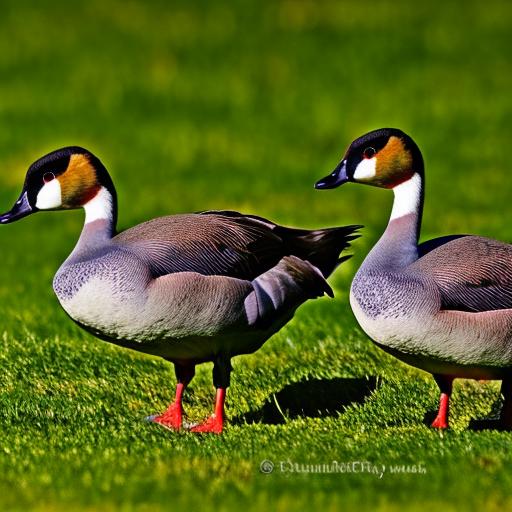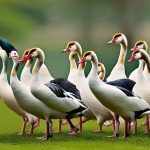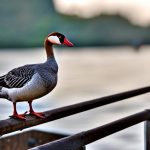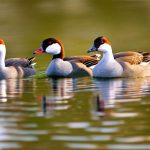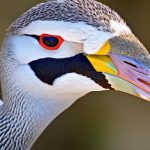Canada geese, also known as Canadian geese, are large waterfowl native to North America. They are known for their distinctive black heads, white cheeks, and brown bodies. Canada geese are highly adaptable and can be found in a variety of habitats, including urban areas. While they may be a beautiful sight to behold, they can also cause significant damage to lawns and pose a safety risk.
When Canada geese congregate on lawns, they can cause extensive damage to the grass. Their constant grazing can result in bald patches and uneven growth. Additionally, their droppings can create unsightly messes that are difficult to clean up. Not only do these droppings detract from the aesthetic appeal of a lawn, but they can also pose health risks to humans and pets. Canada goose droppings can contain harmful bacteria such as E. coli and Salmonella.
Key Takeaways
- Canada geese can cause significant damage to lawns and pose health risks to humans.
- Understanding the behavior of Canada geese is important in developing effective deterrent strategies.
- Keeping Canada geese off your lawn is crucial to prevent damage and health hazards.
- Signs of Canada goose infestation include droppings, feathers, and damage to grass and plants.
- Natural deterrents like landscaping and decoys can help keep Canada geese away from your lawn.
Understanding the Behavior of Canada Geese
Canada geese are migratory birds that travel long distances between their breeding grounds in the north and their wintering grounds in the south. They typically migrate in large flocks, flying in a V-formation for increased efficiency. During the breeding season, Canada geese establish nesting territories near bodies of water such as lakes, ponds, and rivers.
Canada geese are attracted to certain areas, such as lawns, for several reasons. Lawns provide open spaces with easy access to food sources such as grass and insects. They also offer clear lines of sight that allow the geese to spot potential predators from a distance. Additionally, lawns near bodies of water provide an ideal habitat for Canada geese as they can easily access both food and water.
The Importance of Keeping Canada Geese Off Your Lawn
It is important to keep Canada geese off your lawn due to the potential damage they can cause. Their constant grazing can result in the destruction of grass, leaving behind bare patches and uneven growth. This can significantly impact the aesthetic appeal of a lawn and require costly repairs. Additionally, their droppings can create unsightly messes that are difficult to clean up.
Furthermore, Canada goose droppings can pose health risks to humans and pets. The bacteria present in their droppings, such as E. coli and Salmonella, can cause illnesses if ingested. This is especially concerning for households with young children or individuals with compromised immune systems. By keeping Canada geese off your lawn, you can help maintain a safe and healthy outdoor space.
Identifying Signs of Canada Goose Infestation on Your Property
It is important to be able to identify signs of a Canada goose infestation on your lawn in order to take appropriate action. One of the most obvious signs is the presence of large amounts of droppings scattered across the lawn. Canada goose droppings are typically greenish-brown in color and have a cylindrical shape.
Another sign of a Canada goose infestation is the presence of feathers on the lawn. As geese molt their feathers, they may leave behind a trail of feathers as evidence of their presence. Additionally, if you notice large groups of geese congregating on your lawn or near bodies of water nearby, it is likely that you have a Canada goose infestation.
It is important to note that Canada goose droppings can be easily mistaken for those of other birds, such as ducks or seagulls. However, Canada goose droppings are typically larger in size and have a distinct cylindrical shape. They also tend to be more concentrated in certain areas where the geese spend a significant amount of time.
Natural Deterrents to Keep Canada Geese Away from Your Lawn
There are several natural methods that can be used to deter Canada geese from your lawn. One effective method is to plant certain types of vegetation that geese find unappealing. For example, tall grasses and shrubs can create barriers that make it difficult for geese to access the lawn. Additionally, planting vegetation that is not palatable to geese, such as prickly or thorny plants, can help deter them from landing on your lawn.
Another natural deterrent is the use of visual deterrents such as scarecrows or reflective objects. These can create a sense of danger and make geese feel uncomfortable, causing them to avoid the area. Additionally, using noise deterrents such as wind chimes or motion-activated sprinklers can startle geese and discourage them from landing on your lawn.
While these natural methods can be effective in some cases, they may not always provide a long-term solution. Canada geese are highly adaptable and may become accustomed to these deterrents over time. Therefore, it is important to consider other methods in conjunction with natural deterrents for optimal results.
Physical Barriers to Prevent Canada Geese from Entering Your Property

Physical barriers can be an effective way to keep Canada geese off your lawn. One option is to install fencing around the perimeter of your property. This can create a physical barrier that prevents geese from accessing your lawn. However, it is important to ensure that the fencing is at least three feet high and extends underground to prevent geese from flying over or digging under the barrier.
Another option is to use netting to cover areas of your lawn where geese are likely to congregate. This can prevent them from landing and grazing on the grass. However, it is important to ensure that the netting is securely fastened and does not pose a safety risk to other wildlife or pets.
While physical barriers can be effective in keeping Canada geese off your lawn, they may not always be practical or aesthetically pleasing. It is important to consider the pros and cons of each type of barrier and choose the option that best suits your needs.
Using Sound and Light to Scare Canada Geese Away from Your Lawn
Sound and light devices can be used to scare Canada geese away from your lawn. These devices emit loud noises or flashing lights that startle geese and make them feel uncomfortable. For example, propane cannons or air horns can be used to create loud noises that mimic the sound of a predator. Additionally, strobe lights or laser devices can be used to create flashing lights that deter geese from landing on your lawn.
These devices work by disrupting the geese’s sense of security and making them feel threatened. However, it is important to note that these devices may not be effective in all situations. Canada geese are highly adaptable and may become accustomed to the sounds or lights over time. Therefore, it is important to use these devices in conjunction with other methods for optimal results.
Professional Services for Canada Goose Control and Removal
If natural deterrents and physical barriers are not effective in keeping Canada geese off your lawn, you may need to consider professional services for control and removal. There are companies that specialize in Canada goose management and can provide expert advice and assistance.
Professional services for Canada goose control and removal typically involve the use of non-lethal methods such as habitat modification or harassment techniques. For example, they may use trained dogs to chase geese away or install devices that emit distress calls or predator sounds. These methods are designed to deter geese from landing on your lawn without causing harm to the birds.
The cost of professional services for Canada goose control and removal can vary depending on the size of your property and the extent of the infestation. It is recommended to contact multiple companies for quotes and compare their services before making a decision.
Legal Considerations for Canada Goose Management on Private Property
When managing Canada geese on private property, it is important to consider the legal implications. In some areas, Canada geese are protected under federal or state laws, and it may be illegal to harm or disturb them without the appropriate permits. Therefore, it is important to familiarize yourself with the regulations in your area before taking any action.
In some cases, permits may be required to implement certain management techniques, such as egg addling or nest removal. These permits are typically issued by wildlife agencies and may require proof of a significant problem or threat to public health and safety.
It is recommended to consult with local wildlife agencies or professionals who specialize in Canada goose management to ensure that you are in compliance with the law.
Maintaining a Goose-Free Lawn for a Beautiful and Safe Outdoor Space
In conclusion, keeping Canada geese off your lawn is important for maintaining a beautiful and safe outdoor space. These birds can cause significant damage to lawns through their constant grazing and leave behind unsightly droppings. Additionally, their droppings can pose health risks to humans and pets.
There are several methods for deterring or removing Canada geese from your lawn. Natural deterrents such as planting certain types of vegetation or using visual and noise deterrents can be effective in some cases. Physical barriers such as fencing or netting can also prevent geese from accessing your lawn. Sound and light devices can be used to scare geese away, although their effectiveness may vary.
If these methods are not effective, professional services for Canada goose control and removal can provide expert advice and assistance. However, it is important to consider the legal implications and obtain the necessary permits if required.
By taking proactive measures to keep Canada geese off your lawn, you can maintain a beautiful and safe outdoor space for you and your family to enjoy.
If you’re tired of dealing with Canada geese invading your lawn, you might want to consider some alternative solutions. One effective method is to introduce quails to your property. These small birds not only help control pests but also have a taste for certain vegetables that geese find irresistible. To learn more about what vegetables quails eat and how they can help keep Canada geese at bay, check out this informative article on poultrywizard.com. It’s time to reclaim your lawn from those pesky geese!
FAQs
What are Canada geese?
Canada geese are a species of waterfowl that are native to North America. They are known for their distinctive black heads and necks, white cheeks, and brown bodies.
Why do Canada geese come onto lawns?
Canada geese are attracted to lawns because they provide a source of food and water. They will graze on grass and other vegetation, and may also drink from ponds or other bodies of water on the property.
What problems can Canada geese cause on lawns?
Canada geese can cause a number of problems on lawns, including damage to grass and other vegetation, accumulation of droppings, and aggressive behavior towards humans or pets.
How can I keep Canada geese off my lawn?
There are several strategies that can be used to keep Canada geese off your lawn, including installing physical barriers like fences or netting, using repellents like noise makers or visual deterrents, and modifying the landscape to make it less attractive to geese.
Are there any laws protecting Canada geese?
Yes, Canada geese are protected under the Migratory Bird Treaty Act, which prohibits the hunting, killing, or possession of migratory birds without a permit. However, there are exceptions for certain situations, such as when geese are causing damage to property or posing a threat to human safety.
Meet Walter, the feathered-friend fanatic of Florida! Nestled in the sunshine state, Walter struts through life with his feathered companions, clucking his way to happiness. With a coop that’s fancier than a five-star hotel, he’s the Don Juan of the chicken world. When he’s not teaching his hens to do the cha-cha, you’ll find him in a heated debate with his prized rooster, Sir Clucks-a-Lot. Walter’s poultry passion is no yolk; he’s the sunny-side-up guy you never knew you needed in your flock of friends!

